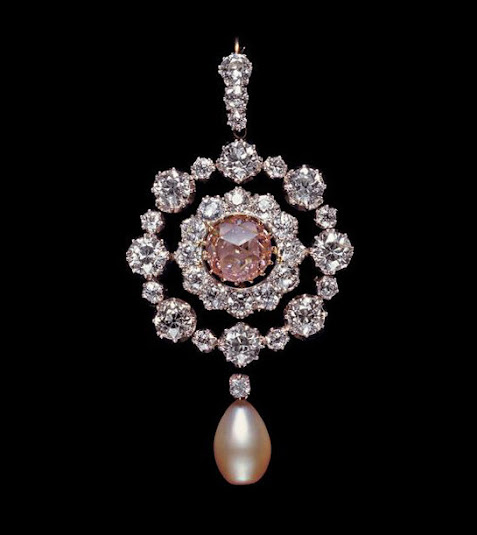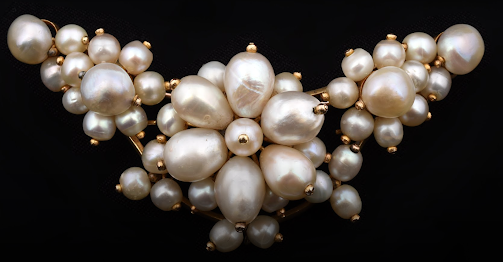 |
| Made in 1800, I couldn’t find any history on it. Who made it? Who owned it? Can anyone solve the mystery? |
I'll show you a few pieces that caught my eye.
Above 👆is a diamond brooch centered by a cushion shaped rare pink diamond with a gorgeous drop pearl. Breathtakingly beautiful, it is mounted in gold. ©1800
The Rosebery tiara was designed in London by Garrard in 1878 for Hannah Rothchild upon her marriage to the Earl of Rosebery, making her Countess Rosebery. It has large diamonds and natural Pacific Ocean Pearls.

Although the famed Pearl Carpet of Baroda wasn’t in the 2018 exhibit (no mention that it was), it is a centerpiece in the National Museum of Qatar's permanent collection. The opulent carpet was commissioned by Khande Rao Gaekward, the Maharaja (governor) of Baroda, in 1865. It has over 1.5 million Basra pearls, diamonds, sapphires, emeralds, and rubies. The gemstones are embroidered onto a deerskin and silk backing. The Maharaja had it made to cover the tomb of the Prophet in Medina, but then couldn’t part with it, so it stayed in his family until 2009 when it sold at auction.
Pearls are timeless and elegant! What a magnificent show for the lucky folks who saw it! The 1st brooch might be my favorite piece, if forced, forced, forced to choose, even though we don’t really wear brooches anymore. The brooch's pink diamond and pink drop pearl are flawless and gorgeous! Which one is your favorite?𓆉🐌🐚🦀
If you wish to learn more about pearls click the 1st link, below.⚪
Pearls are timeless and elegant! What a magnificent show for the lucky folks who saw it! The 1st brooch might be my favorite piece, if forced, forced, forced to choose, even though we don’t really wear brooches anymore. The brooch's pink diamond and pink drop pearl are flawless and gorgeous! Which one is your favorite?𓆉🐌🐚🦀
If you wish to learn more about pearls click the 1st link, below.⚪
You may also enjoy:


































